Alternator shim
|
The old charge wire can be taped up? I was under the impression it had to be hooked up as all power flowed through that one wire to the whole truck.
If it could be simply left off that would save me some trouble as I dont even think my ammeter even works but in the off chance it does, I hate for it to constantly show discharge all the time.
"Old Blue" - '56 Fairlane Town Sedan - 292-4V, Ford-O-Matic transmission, 3.22:1
'63 Belair 2dr sdn - 283-4V, Powerglide transmission, 4.56:1 '78 Cougar XR7 - 351-2V, FMX transmission, 2.75:1 9inch "Bruno" - '82 F150 Flareside - 302-2V, C6 transmission, 2.75:1 9inch, 31x10.50-15 BFG KO2 |
|
Administrator
|
Not the charge wire, the ammeter wire and shunt.
That's why you go around the shunt, directly to the yellow main power wire. I forget the wire number... (30???) and the splice # where it joins shunt and ammeter, but it is that simple.
Jim,
Lil'Red is a '87 F250 HD, 4.10's, 1356 4x4, Zf-5, 3G, PMGR, Saginaw PS, desmogged with a Holley 80508 and Performer intake. Too much other stuff to mention. |
|
Administrator
|
This post was updated on .
Ok, I'm looking at this and it seems that you have to make it up yourself.
There's a piece of cable, a regulator plug, a stator plug, a Lillelfuse fuse holder, some lugs and butt crimps. Edit: You'd think they'd at least give you some insulated lugs, or some heavy red heat shrink to insulate the charge cable lugs at the fuse and relay... 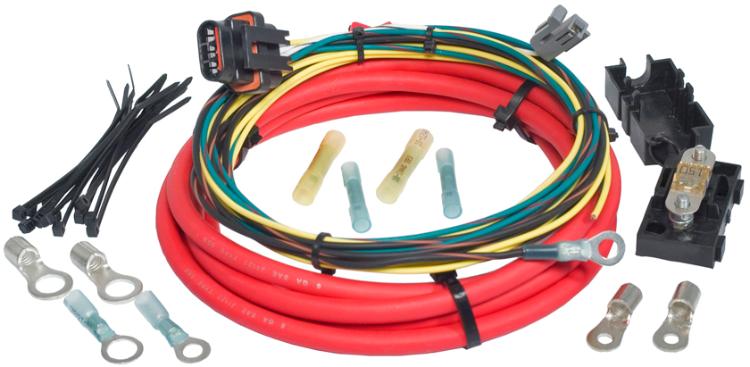 I'm not sure what that black/orange wire with the eyelet is. With a 2G, you have two bk/o 10Ga. wires coming from the fire plug, that splice to a single fusible link. That's where the problems start. If the fusible link in that setup goes out the alternator immediately goes full field, because the sense wire is on the other side, and no matter how many volts the alternator is pushing the regulator doesn't know it.
Jim,
Lil'Red is a '87 F250 HD, 4.10's, 1356 4x4, Zf-5, 3G, PMGR, Saginaw PS, desmogged with a Holley 80508 and Performer intake. Too much other stuff to mention. |
|
Administrator
|
In reply to this post by ArdWrknTrk
Ok Rusty, wire 37 at splice 202.
http://www.garysgaragemahal.com/3g-conversion.html
Jim,
Lil'Red is a '87 F250 HD, 4.10's, 1356 4x4, Zf-5, 3G, PMGR, Saginaw PS, desmogged with a Holley 80508 and Performer intake. Too much other stuff to mention. |
|
In reply to this post by ArdWrknTrk
They do give you that heat shrink for all connectors. I’m not sure why it’s not showing in that pic. The eyelet wire is for the alternator ground. I can post the install instructions they sent with the kit. I think the one I have is specific for 1g to 3G set up.
As far as going around the shunt - where is the shunt? I’ve googled the hell out of it and I’m just not finding it. I can’t follow the link to the 3G upgrade page to look at wire 37. I know there’s some hosting issues Gary is working on, but that page has only worked for me a few times - even after resetting my internet.
1983 Bronco 4.9 300 I6
Current Name: Whitney |
|
Administrator
|
You can't get to the Documentation/Electrical/3G Upgrade page??????????? I'm not working on anything that will fix that as the problems are in the forum's host and not the documenation's host. (Too much detail?) Are you running an ad blocker? Sometimes those do strange things.
Here's the page that shows the shunt. And you are looking for the splices - S203 and S202. S203 is very near the starter relay and S202 is closer to the heater motor, both in the black/orange wire. In Big Blue you could tell what was the shunt and what was normal wire as the shunt's insulation was different. But, it is the wire between those two splices, and they are fairly easy to find as there are three and four wires, respectively, coming out of them. 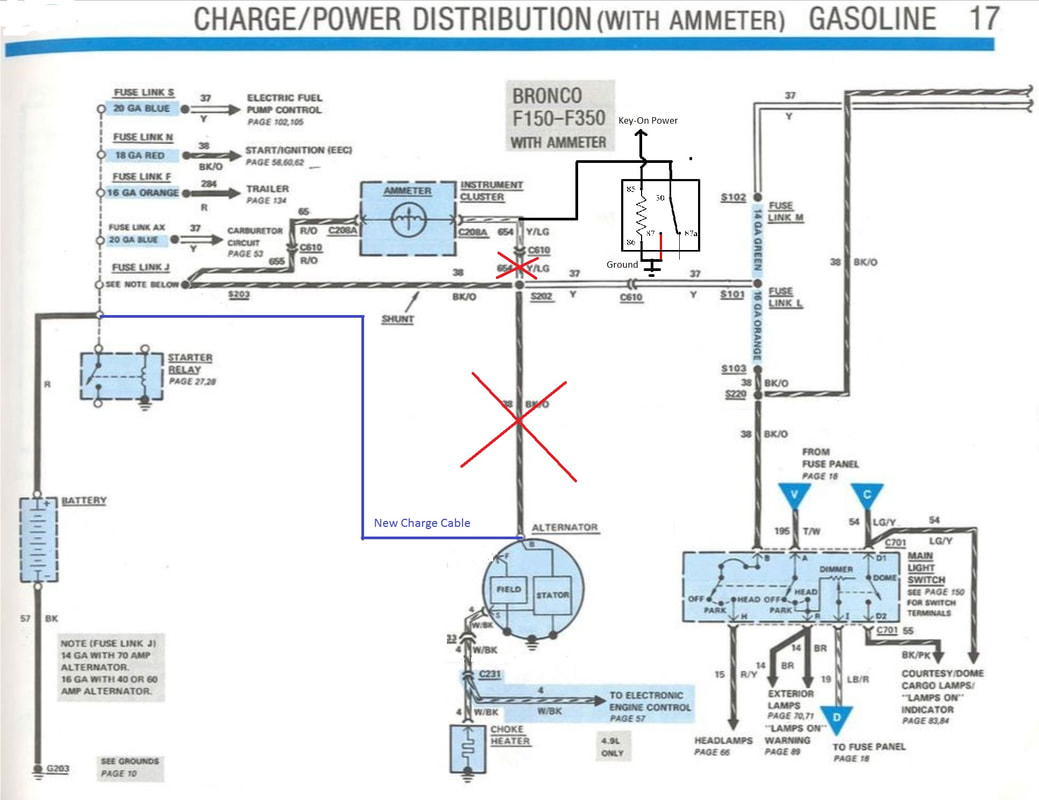 Gary, AKA "Gary fellow": Profile
Gary, AKA "Gary fellow": Profile
Dad's: '81 F150 Ranger XLT 4x4: Down for restomod: Full-roller "stroked 351M" w/Trick Flow heads & intake, EEC-V SEFI/E4OD/3.50 gears w/Kevlar clutches
|
|
Administrator
|
In reply to this post by FrazerJames
I'm sorry, I don't have the kit in front of me, just the picture from Painless. 🤷
Ford kept their wire colors the same for many years and across all models. Black with an orange stripe is always alternator power to me. Why Painless wouldn't use straight black for ground is beyond me. I don't even have an alternator ground wire, but the tapped hole is there on the back, and better grounds are always a good idea.
Jim,
Lil'Red is a '87 F250 HD, 4.10's, 1356 4x4, Zf-5, 3G, PMGR, Saginaw PS, desmogged with a Holley 80508 and Performer intake. Too much other stuff to mention. |
On low voltage ground is white, just look at trailer wiring as ground is white. But I do get what you are saying as all cars & trucks ground has always been black. Dave ----
Dave G.
81 F100 flare side 300 six / AA OD / NP435 / 2.75 gear http://cars.grantskingdom1.com/index.php/1980-Ford-F100?page=1 81 F100 style side 300 six/SROD parts truck -RIP http://cars.grantskingdom1.com/index.php/1981-Ford-F100 |
|
Administrator
|
In reply to this post by Gary Lewis
Gary, you should put the fuseholder in your 'new charge cable'
Me, I'd cut out S202. Take 654 from your X to the regulator plug, disconnect fuse link J entirely and connect 37 to either where J was or to the fuseholder that should be shown in your blue line. But, that's me..... 
Jim,
Lil'Red is a '87 F250 HD, 4.10's, 1356 4x4, Zf-5, 3G, PMGR, Saginaw PS, desmogged with a Holley 80508 and Performer intake. Too much other stuff to mention. |
|
Administrator
|
Jim - You are right, several changes need to be made to that. Remind me later as I'm headed out the door to go to church. And then working on BB, then mowing the yard, then.....
But seriously, several changes are needed.
Gary, AKA "Gary fellow": Profile
Dad's: '81 F150 Ranger XLT 4x4: Down for restomod: Full-roller "stroked 351M" w/Trick Flow heads & intake, EEC-V SEFI/E4OD/3.50 gears w/Kevlar clutches
|
|
Administrator
|
In reply to this post by FuzzFace2
Yeah Dave, but this is not trailer wiring Ford wiring, and like I said bk/or is alternator output.
Or at least it always was. I don't have the 'kit', nor the instructions. I see what I can see (on my phone) Stay safe Gary. I'll give you a nudge about this in a few days.
Jim,
Lil'Red is a '87 F250 HD, 4.10's, 1356 4x4, Zf-5, 3G, PMGR, Saginaw PS, desmogged with a Holley 80508 and Performer intake. Too much other stuff to mention. |
|
In reply to this post by ArdWrknTrk
Guess I will have to look at the wiring schematic I thought the shunt and the charge wire was one in the same circuit wise.
Ok looks like the shunt is part of some four pin connector some wheres. Wonder how one would disable that circuit without actually cutting the wires. I dont like cutting original harnesses for the off chance I decide to make a reversion on changes I made. Looks like if I just run a separate charge wire from alternator to my mega fuse that should effectively bypass the shunt. But then again the OE charge wire I am looking at mounting post mega fuse if the wire is long enough. Its a shame Dakota Digital hasnt released their RTX retro gauges for our trucks I would put that on my credit card right now so I can just have the ammeter shunt disconnected completly at the dash.
"Old Blue" - '56 Fairlane Town Sedan - 292-4V, Ford-O-Matic transmission, 3.22:1
'63 Belair 2dr sdn - 283-4V, Powerglide transmission, 4.56:1 '78 Cougar XR7 - 351-2V, FMX transmission, 2.75:1 9inch "Bruno" - '82 F150 Flareside - 302-2V, C6 transmission, 2.75:1 9inch, 31x10.50-15 BFG KO2 |
|
I took the old alternator out which really freed up the visual breakdown wire-wise. I’m basically working with three sets of instructions. The original documentation on this site, Jim’s recommendations and the instructions that came with the Painless kit. At the moment, I’m just trying to identify all the parts of the diagram.
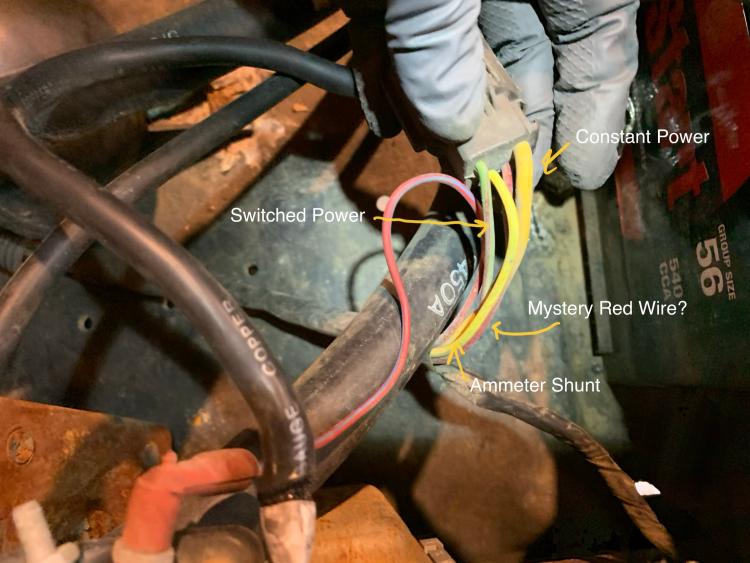 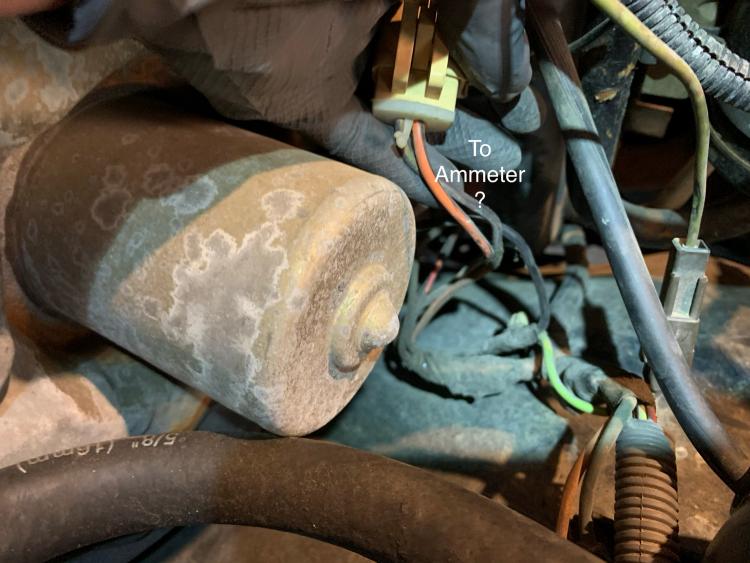 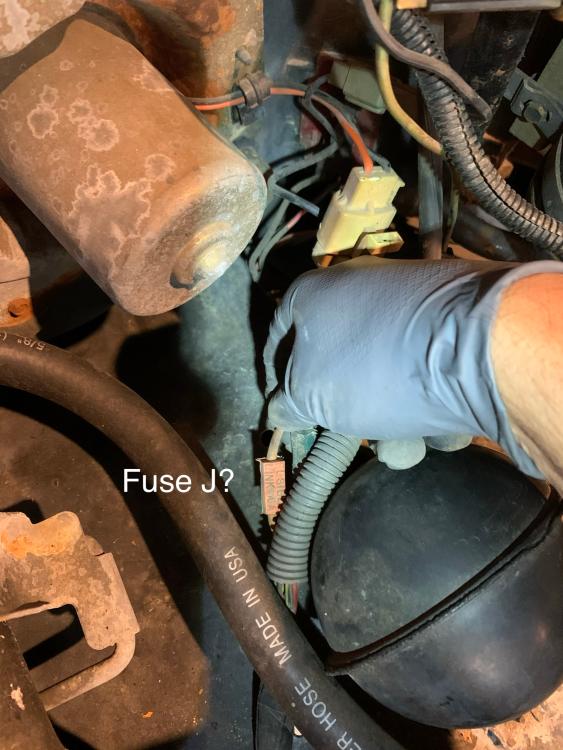 Can anyone confirm what I’ve identified. Fuse J is a total guess.
1983 Bronco 4.9 300 I6
Current Name: Whitney |
|
I will say the instructions provided by Painless are very clear. I’m inclined to just follow them except for that second page warning about disconnecting the Ammeter. It says the wires of the ammeter will need to be reconnected together as they usually supply voltage to the fuse block.
That part is not clear on what I need to do to make it happen. Here’s the rest of the instructions. 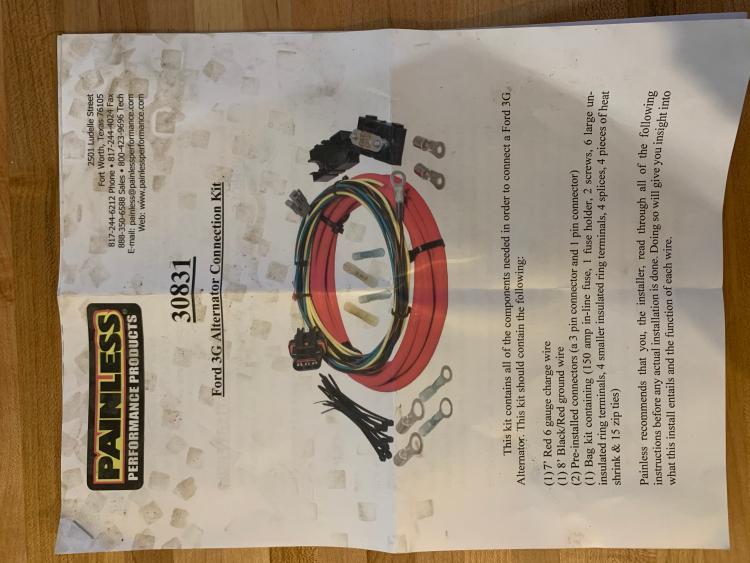 1983 Bronco 4.9 300 I6
1983 Bronco 4.9 300 I6
Current Name: Whitney |
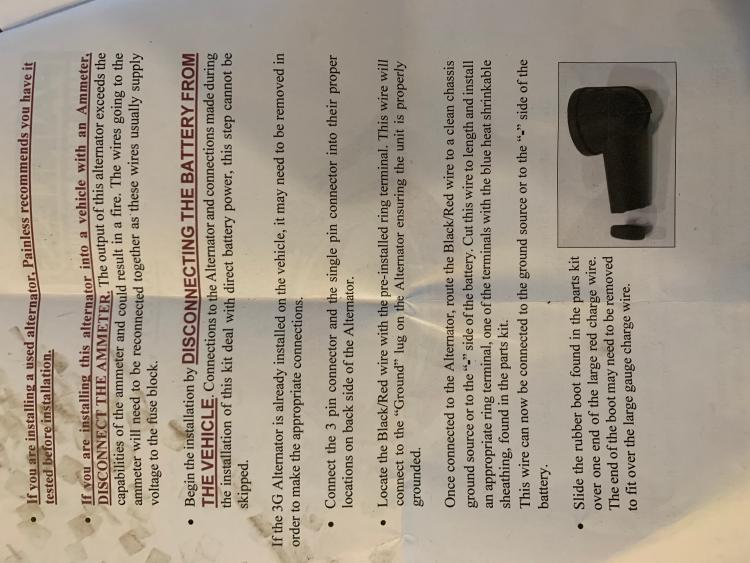 1983 Bronco 4.9 300 I6
1983 Bronco 4.9 300 I6
Current Name: Whitney |
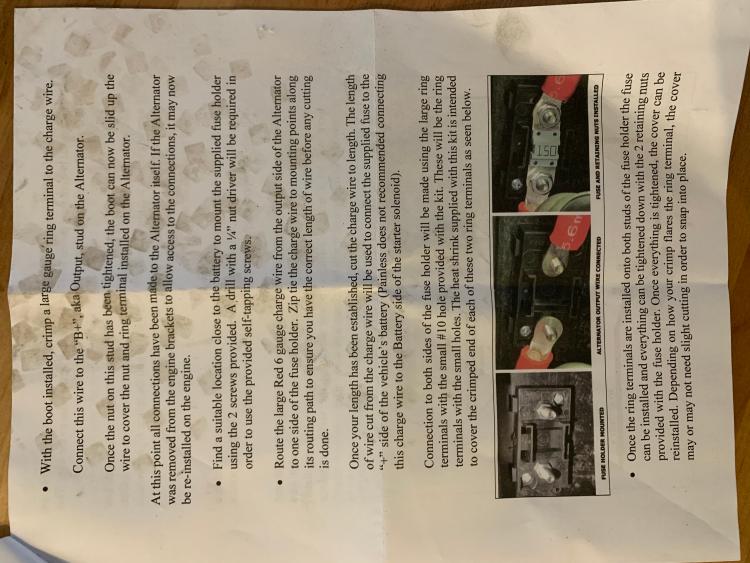 1983 Bronco 4.9 300 I6
1983 Bronco 4.9 300 I6
Current Name: Whitney |
 1983 Bronco 4.9 300 I6
1983 Bronco 4.9 300 I6
Current Name: Whitney |
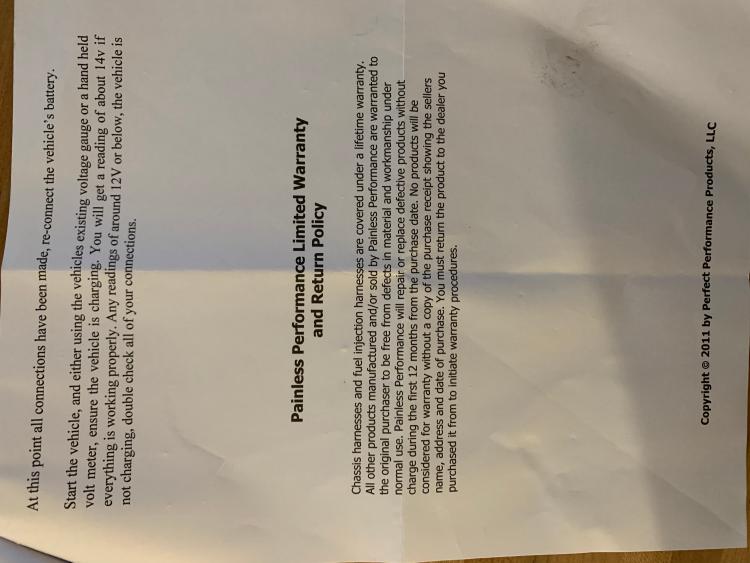 1983 Bronco 4.9 300 I6
1983 Bronco 4.9 300 I6
Current Name: Whitney |
|
Administrator
|
On the ammeter, you basically have two choices, but both of them include connecting the output of the alternator to the starter relay, therefore bypassing the shunt:
1. Leave the ammeter in place. But the ammeter is only going to show the current flowing into the cab, meaning that it'll never show charge, only discharge. But it won't burn up, and the shunt won't burn up unless you put a lot of extra electrical load in the cab.2. Have the ammeter converted to a volt meter.
Gary, AKA "Gary fellow": Profile
Dad's: '81 F150 Ranger XLT 4x4: Down for restomod: Full-roller "stroked 351M" w/Trick Flow heads & intake, EEC-V SEFI/E4OD/3.50 gears w/Kevlar clutches
|
|
Administrator
|
In reply to this post by FrazerJames
These instructions seem clear.
I mistook the ground wire as having an orange -not red- stripe. Mea culpa, but I'm trying to do this from my phone. (I still think it should be straight black) Where I differ from their instructions is that I would have the yellow/white somewhat parallel the black white stator wire in their illustration of the back of the 3G, and go directly to the output stud where you attach the cable. This is a source if constant power, and since it's -before- the fuse, it won't cause the alternator to go crazy and burn itself up in the case that the fuse pops. If you have substantial voltage drop across a couple of feet of 6Ga. wire something else is messed up. Note what I said about bypassing the ammeter. I said to take the big yellow wire from its splice with the key on green/red wire and bring it direct to either the starter relay, or the fused side of the fuse holder. If the ammeter is not in the loop, there is no reason to have the increased power available to pass through the resistive (and undersized) shunt. I'm not trying to cause confusion, or counter the instructions (thank you for posting them) I'm just saying how I do it, and my reasoning behind my choices. I've had the fuse link on my 2G fail, and that fuse going out caused my 2G alternator to burn itself up, because the regulator didn't know better. I hope this is clear. I still can't see what your "mystery wire" is. Maybe you can say what colors are there? My phone isn't too big and my eyesight isn't as good as it was before. I think this upgrade is something any Bullnose owner will appreciate.
Jim,
Lil'Red is a '87 F250 HD, 4.10's, 1356 4x4, Zf-5, 3G, PMGR, Saginaw PS, desmogged with a Holley 80508 and Performer intake. Too much other stuff to mention. |
| Edit this page |

